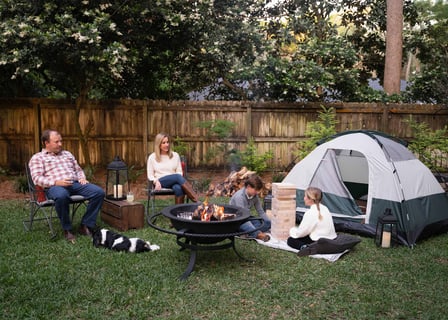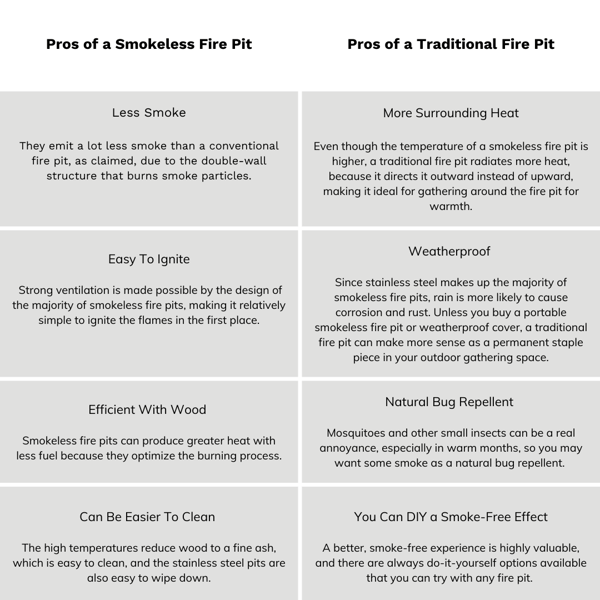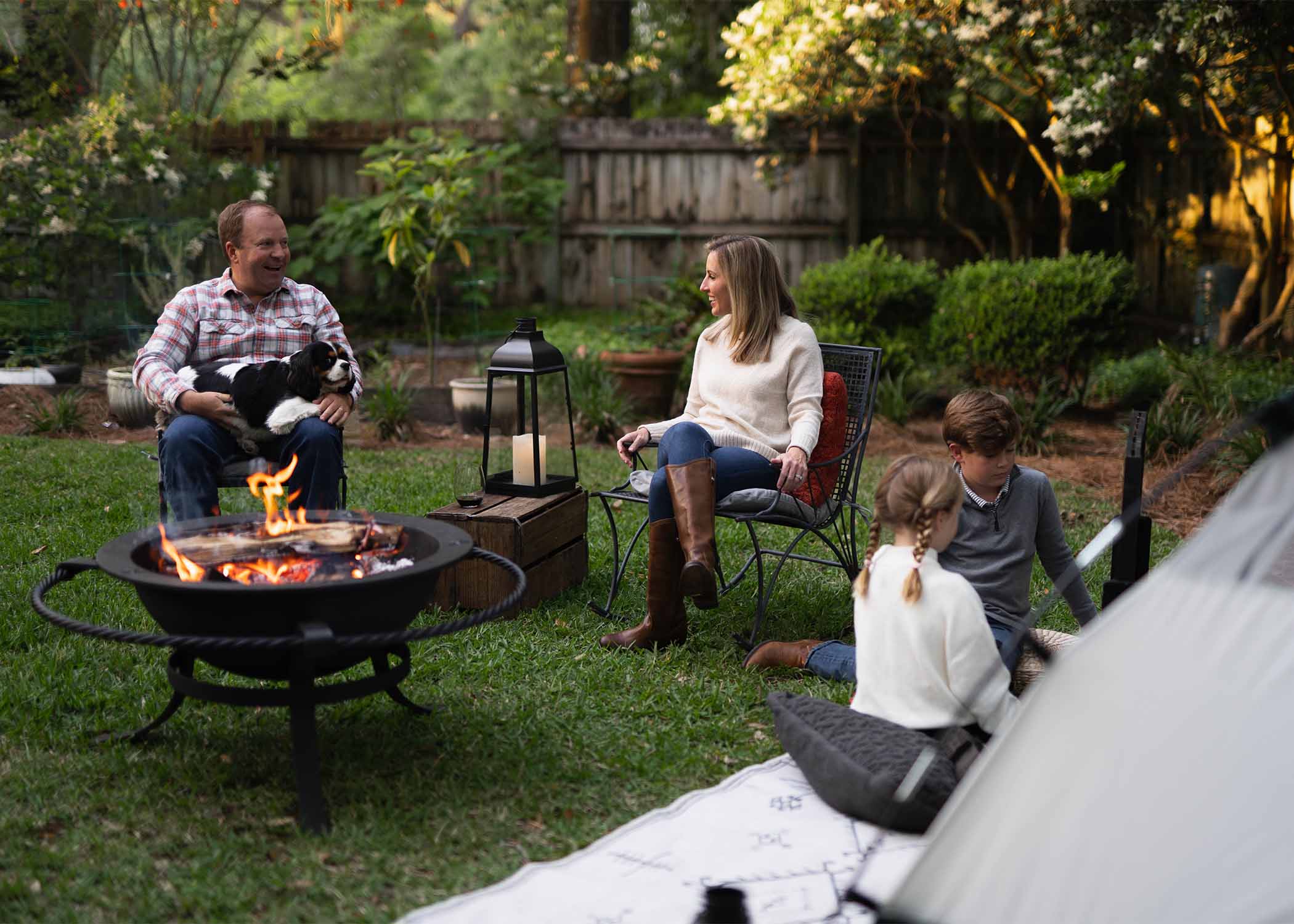Smokeless Fire Pits: How to Make Your Fire Pit Smoke Free
September 15, 2022 by Sea Island Forge
Smokeless Fire Pits: Are They Really Smokeless?
There is nothing more enjoyable than having your friends and family over for a drink or meal and spending the evening chatting around a fire pit. Being the person seated in the improper location with smoke billowing in your face can also be frustrating.
Smokeless fire pits have become a growing trend in the fire pit marketplace. Several fire pit options available right now advertise being smokeless, promising that no one will have to sit in that uncomfortably smokey seat. But is it truly possible to have a smokeless fire pit, or is this just a convenient marketing myth? For a thorough explanation of what smokeless fire pits are, how they operate, and the advantages and disadvantages of purchasing one or making your own fire pit produce less smoke, continue reading.
It's impossible to completely remove all of a fire's smoke, especially when a fire is first ignited. Thus, when you consider this concept, consider "reduced smoke" rather than "smokeless." If you want to know the science behind it, a double-walled fire ring is used in modern smokeless fire pits such as the Solo Stove or Breeo to increase airflow and reduce smoke production. The inner wall is ringed with holes near its top, while the outside wall has holes at its base. Air is sucked into the fire pit through the outer wall when it is lit, and as it comes into touch with the inner wall, it heats up.
The hotter the fire, the more smoke is eliminated. As the air rises between the walls, this hot air eventually pushes through openings along the top of the inner wall, expanding. This motion functions as a somewhat “air pump,” blowing a stream of hot oxygen into the flames to fan them. The heat from this "secondary combustion" causes the smoke particles to be combusted before they can leave the fire pit.

Should I Buy A Smokeless Fire Pit? What Are The Pros And Cons Of A Smokeless Fire Pit?
Here are the advantages of a smokeless fire pit compared to the benefits of a traditional fire pit, such as the Sea Island Forge Fire Kettle.

The truth is that no wood or charcoal fire pit will ever be totally smoke-free. Keep in mind that a natural or propane gas fire pit is always smokeless, as it does not produce the byproducts that cause smoke the way wood and charcoal do. Of course, the best fire pit option is frequently influenced by a certain design you are drawn to or a particular use you have in mind. Look for a versatile firepit such as the Sea Island Forge Grilling System if you want an all-in-one fire pit for cooking with great temperature control, entertaining, and gathering.
Also, aesthetics are important if you want a fire pit with a distinct appearance. The fire pit you are looking for may also need to be kept on a patio, in which case you'll need a model with an incorporated or add-on stand to keep the heat safely elevated. Consider your values when you evaluate various firepit models if you’re looking to purchase a new one. If you already have a fire pit and are looking to reduce smoke, here are some tips.
Here Are Some Tips To Make Your Fire Pit More Smoke-Free
By its very nature, smoke is produced by burning things. While a completely smokeless fire pit is not possible, we can get close. In general, there are a few steps you can take to reduce fire pit smoke. When we think of a classic fire pit, we think of a wood-crackling campfire - the tranquil crackle, the orange light flickering over your face in the dusk. Wood is the perfect go-to for a nice gathering around a warm fire, except of course for the burning wood smoke that seems to follow you everywhere you go.
1. Use seasoned fire pit wood ONLY
Smoke will still inevitably be produced while burning wood, but you can take several steps to reduce smoke in your wood-burning fire pit experience. First, smoke typically results from inadequate wood burning brought on by moisture. So, you will want to use properly seasoned wood to cut down on smoke production.
What is seasoned firewood?
Low moisture level indicates that the firewood has been properly seasoned, making it simpler to light and burn, is cleaner, more effective, and less creosote-producing. Use good well-seasoned hardwood; this is the easiest and most effective approach to reduce the smoke from your fire pit.
Additional smoke will be produced if the wood has any moisture. Make sure the wood you're using is dry, which means that the tree was cut at least a year earlier and the wood has had ample time to dry out. Also, fueling your fire with hardwood will result in far less smoke than any softwood. Your best bet for lowering the quantity of smoke your fire pit emits is to purchase kiln-dried, seasoned hardwood. *Helpful tip, place firewood under the bowl of a standing traditional fire pit to season and dry your wood while you enjoy being cozy by the fire.
2. Secondly, do not burn anything else in your fire!
Many people dump newspapers, cardboard boxes, leaves, paper plates, and anything else into their fires without thinking, which all burn inefficiently and emit a ton of smoke. Kindly ask your guests to refrain from throwing any trash into the fire, and their smoke-free eyes will thank you later.
The key is to burn just your seasoned hardwood in the fire pit if you want to reduce smoke. With this in mind, clean out and regularly maintain your fire pit. All of the residual ash and wood shavings can build up over time and will have a major impact on the amount of smoke produced by your fire, as any particles of debris in your fire pit often generate additional smoke. A cleaner fire pit equals cleaner air.
3. Store your wood in a dry place
Even if you buy the best-seasoned wood you can get, you will still experience excessive smoke if you don't store it properly and keep it nice and dry. Maintaining the quality of the wood you intend to burn requires protecting it from the outdoors, especially during chilly or wet weather.
Tips for storing firewood
- Keep firewood stacked off the ground. Even hard surfaces, especially soil-covered ones, can maintain moisture that comes from the wood. Pallets are useful in these cases.
- Let the wood be exposed to the wind and sun to help it cure. A woodpile covered with tarps entirely retains moisture.
- Use a cover that allows the sides to remain open while keeping snow and rain off the top layer of wood. A log rack, a tarp with a frame, or an open-sided shed would be ideal for covered wood storage.
- Logs should be lengthened and split to create more surface area so that they can season more quickly. Ideally, wait six months before you burn your wood in order to allow it to properly season and dry out.
The Sea Island Forge Log Rack checks all of these boxes with its clever layout and solid construction. The wood rack has open sides that let the sun and wind help the wood cure, as well as a cover to keep it dry. Over time, the lid also lowers along with your wood stack.
4. Build your fire well
In order to minimize smoke, it's also crucial to build your fire properly to create the optimum amount of ventilation. You will want to start with chopping wood into smaller pieces and then using these small pieces to start the fire. Split logs are easier to light and burn better than whole logs, so you will continue to add larger split logs later (We have a detailed step-by-step of this over at Building the Perfect Fire). We suggest a criss-cross method of building a fire in the middle of your Sea Island Forge Fire Kettle or wherever you're starting your fire, to maintain optimal airflow and reduce smoke. Once you light the smaller pieces, this criss-cross formation will create an ideal amount of airflow and core heat in your fire pit. Eventually, throughout the evening, once the grid has completely burnt away, you can add larger pieces of wood to create a teepee-like structure to continue to encourage your airflow.
Overall, a fire pit’s smoke cannot be entirely extinguished, especially when it first starts even in the ever-trending smokeless fire pit. There are both benefits and drawbacks of buying a smokeless fire pit, especially because you can easily reduce smoke in a traditional fire pit you already have. It's not difficult to reduce the quantity of smoke your fire pit creates; all it takes is a little extra caution, practice in picking the right kind of wood when you do use wood and maintain a better-built fire.


